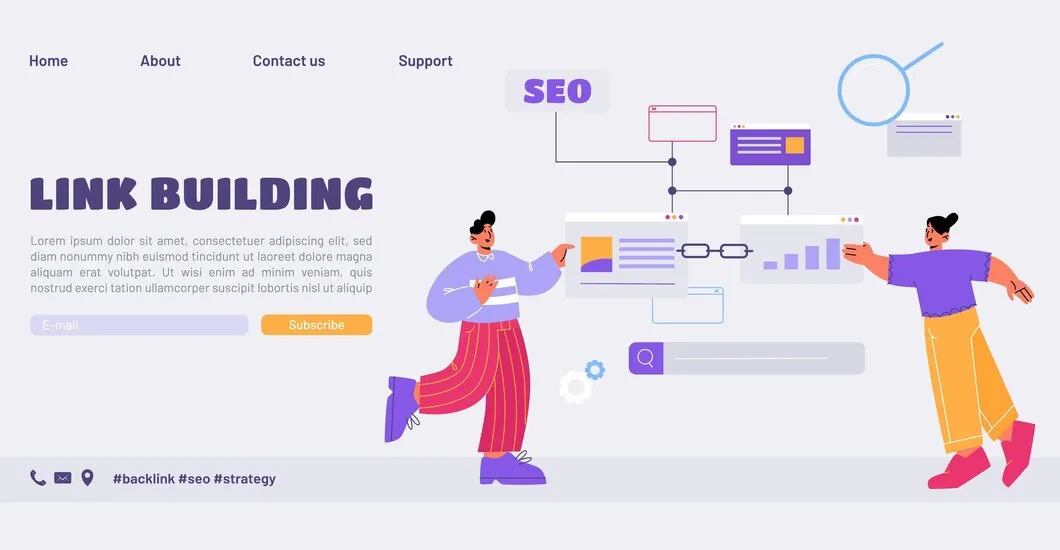Understanding Backlinks in SEO: A Beginner’s Guide to Benefits and Usage

A legend once said, “It is the SEO’s world, and we are just living in it.” Ever since search engines were invented, SEO has played a dominant role in curating search results that match users’ expectations when surfing the internet.
It also plays a pivotal role in all the other chains of command, such as content, visuals, and, let’s not forget, the all-important “backlinks.” Backlinks help you build a bridge between your website and the top search engine results pages.
SEO determines how likely your website will appear on search results when a user types a query similar to what you offer. It’s like a recommendation from Google itself. The goal is to be relevant and show the right content to the right audience.
On the other hand, backlinks are the unsung heroes that direct your audience through a link shared on another website. The more reputed the website, the better the quality of your backlink will be. Again, it’s a recommendation from a website of higher authority.
What Are Backlinks?
Backlinks are like digital recommendations that drive traffic to your website from another website through a link. Websites with a good reputation and high monthly user visits offering a backlink are considered high-quality backlinks.
Through backlinks, a user can travel from one corner of the internet to another with just a simple click. They are a means of generating organic traffic, where trusted sources act as catalysts to boost website traffic.
Types of Backlinks (Dofollow, Nofollow)
Not all backlinks are the same. They differ in their purpose. There are two main types of links: dofollow links and nofollow links. Dofollow links are like VIP passes. Search engines track them and consider them when ranking pages.
On the other hand, nofollow links are specifically used to mention that search engines do not consider these links to be a ranking factor for those pages. In terms of traffic, both play the same role.
But in terms of playing an integral role in search engine rankings, dofollow links are where you should focus.
The Benefits of Backlinks
The question that arises is why we need backlinks in the first place. So, here are a few advantages of backlinks we need to keep in mind while creating them.
1. Improved Search Engine Rankings
At the heart of the backlink’s impact lies its ability to propel a website to the forefront of search engine results. The more high-quality backlinks a website accumulates, the higher its chances of securing top positions in relevant search queries. It’s a competitive advantage that can’t be overstated in the digital landscape.
2. Increased Website Authority
Website authority is the online currency that translates to trustworthiness. Quality backlinks act as testimonials, vouching for the credibility of a website. As the number of these endorsements grows, so does the website’s authority, elevating it to a position of influence in its niche.
3. Enhanced Organic Traffic
Backlinks serve as bridges connecting one corner of the internet to another. When reputable sites link to yours, they’re essentially paving a road for their audience to discover your content. This influx of new visitors, driven by organic search, is a direct result of effective backlink strategies.
4. Building Brand Credibility
Trust is the foundation upon which brands are built in the digital landscape. Quality backlinks contribute to this trust by associating your brand with established and reliable sources. This association goes a long way in building brand credibility, a valuable asset in the eyes of both search engines and users.
How to Earn Quality Backlinks
1. Creating High-Quality Content
The cornerstone of any successful backlink strategy is crafting content that stands out. When your content provides real value, it becomes a magnet for backlinks.
Conduct thorough research, offer unique insights, and ensure your content is well-written and easily digestible. Remember, quality content is the bedrock upon which backlink relationships are built.
2. Guest Blogging Strategies
Guest blogging is a tried-and-true method for acquiring backlinks while expanding your reach. Identify reputable websites in your niche and offer to contribute insightful, relevant content. In your author bio, include a link back to your site. It’s a win-win – you get exposure, and the hosting site gets valuable content.
3. Social Media Outreach for Backlinks
Social media is more than just cat memes and status updates; it’s a dynamic platform for building backlinks. Share your content strategically across various social media channels, engage with your audience, and encourage them to share.
The more visibility your content gets, the higher the chances of it attracting quality backlinks.
4. Building Relationships Within Your Niche
In the digital realm, relationships matter. Connect with influencers, bloggers, and businesses within your niche.
Engage in genuine conversations, offer insights, and show support for their content. As relationships grow, so does the likelihood of them naturally linking to your valuable resources.
Tools for Backlink Analysis
In the ever-evolving world of SEO, having the right tools at your disposal can make all the difference in understanding and optimizing your backlink profile. Let’s explore some essential tools for backlink analysis that can help you fine-tune your strategy:
1. Google Search Console
Think of Google Search Console as your backstage pass to understanding how Google sees your website. It provides valuable insights into your backlink profile, highlighting who links to your site and which pages are most linked.
Use this data to identify high-performing content and areas for improvement in your link-building efforts.
2. Ahrefs
Ahrefs is like a superhero in the world of SEO tools. It not only shows you who’s linking to your site but also unveils the strategies of your competitors. Dive deep into backlink analysis, discover new link-building opportunities, and keep a vigilant eye on your website’s health with Ahrefs’ comprehensive suite of features.
3. Moz
Moz is your SEO Swiss army knife. Its Link Explorer tool lets you explore backlinks, understand your domain authority, and track your website’s performance over time. Moz also provides valuable metrics like spam score, helping you keep your backlink profile clean and reputable.
4. SEMrush
SEMrush is an all-encompassing toolkit that extends beyond backlink analysis. Use the Backlink Analytics feature to assess your link-building efforts and those of your competitors. Gain insights into referring domains, anchor text, and the overall quality of your backlinks. SEMrush is a must-have for anyone serious about SEO.
This guide is a testimony to the process followed by Mavlers experts when generating backlinks for their clients.
Mavlers is a new-age digital marketing agency that collaborates with small —and large-scale businesses to generate organic traffic on their websites through backlinks. These are tried-and-tested strategies for ditching the traditional backlinking style and adopting the dynamic landscape of backlinks in SEO.
Key Takeaways
Backlinks don’t just drive traffic back to your website; they also contribute to its SEO, eventually helping it rank higher on search engine results pages.
A high-quality backlink solidifies your website’s authority in that particular domain. Both your users and search engines value your brand name. Thus, quality backlinks are a kind of long-term investment in a strong online presence.





